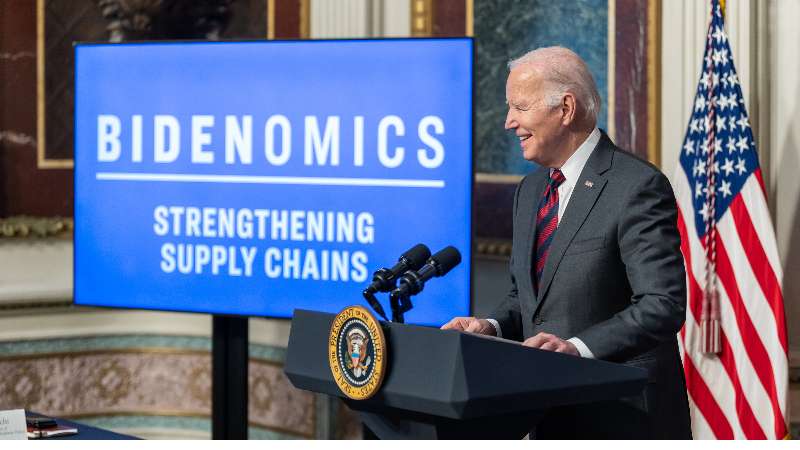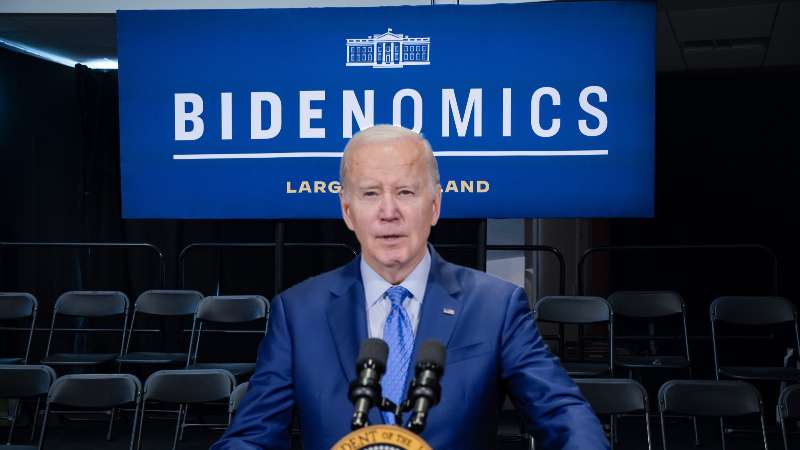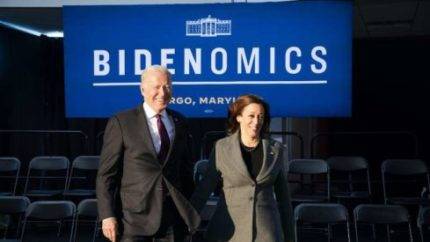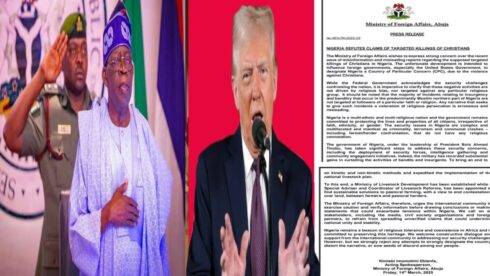Embarking on a journey through the economic archives, “Bidenomics” emerges as a defining chapter in the narrative of American economic policy. President Joe Biden’s vision for the nation’s economic trajectory, encapsulated by this term, unfolds against the backdrop of historical challenges. The roots of Bidenomics can be traced back through the intricate tapestry of events, from the aftermath of the Great Recession to the unprecedented challenges posed by the COVID-19 pandemic. It stands as a strategic response, a nuanced and comprehensive approach crafted to fortify American resilience in the face of unforeseen economic turbulence.
Bidenomics, as a multifaceted economic strategy, goes beyond mere crisis management. It represents a recalibration of economic priorities, embracing inclusivity and sustainability. Delving into the layers of this approach, one finds a commitment to infrastructural revitalization, social welfare enhancement, and a transformative shift towards green initiatives.
This comprehensive strategy not only aims to mend the immediate economic wounds inflicted by crises but also positions the United States on a trajectory of sustainable growth. As we scrutinize the historical markers that define Bidenomics, it becomes evident that this economic philosophy is not just a response to challenges but a roadmap for shaping a resilient and progressive American economic future.
Strengthening American Supply Chain
In a pivotal move to secure and fortify American supply chains, the Biden administration has embarked on a determined course of action that forms the bedrock of its economic strategy, aptly termed Bidenomics. This strategic shift stems from a comprehensive assessment of vulnerabilities laid bare by the global pandemic, prompting the government to proactively address shortcomings in the nation’s supply chain resilience. Central to this initiative are substantial investments in critical industries, a collaborative approach with the private sector, and the forging of strategic alliances with allied nations.
The multifaceted approach undertaken by the administration is geared towards bolstering domestic production capabilities, a key step in reducing dependency on foreign sources. By injecting funds into critical industries and fostering partnerships with private enterprises, the government aims to build a more self-reliant and resilient economic infrastructure.
Moreover, the emphasis on strategic alliances with allied nations not only strengthens diplomatic ties but also creates a united front against potential disruptions. This concerted effort not only enhances national security by mitigating vulnerabilities but also positions the United States as a formidable player in the global economic arena, fostering competitiveness and sustainability in the face of evolving challenges.

Revitalizing American Manufacturing: A Bidenomics-Led Renaissance
In a strategic move under the Bidenomics agenda, the spotlight is now on a comprehensive revitalization of American manufacturing. The administration’s ambitious plan entails a multifaceted approach, leveraging incentives, strategic tax reforms, and targeted investments to invigorate the nation’s industrial sector. This visionary initiative is poised to usher in a new era marked by job creation, heightened innovation, and a steadfast commitment to sustainability.
At the core of this transformative agenda is a commitment to fostering an environment conducive to manufacturing growth. The administration envisions a resilient and dynamic industrial base that not only revitalizes local economies but also propels the nation towards sustained economic prosperity. The nuanced combination of incentives seeks to encourage businesses to invest in advanced technologies and sustainable practices, positioning American manufacturing at the forefront of global competitiveness. With a focus on job creation, innovation, and sustainability, this revitalization effort aims to redefine the landscape of American manufacturing, positioning it as a powerhouse in the global economic arena.
Empowering American Workers: A Cornerstone of Bidenomics
In the landscape of economic policy, the heartbeat of Bidenomics resonates with a dedicated commitment to bolstering the American workforce. Central to this ideology are policies meticulously designed to ensure fair wages, safeguard workers’ rights, and foster substantial investments in education and training programs. The Biden administration‘s strategic focus on enhancing the well-being and skill sets of American workers forms the bedrock of an ambitious vision — to forge a labor market that stands resilient in the face of the dynamic demands posed by the 21st-century economy.
At its core, Bidenomics places a premium on the dual pillars of well-being and skill development. By emphasizing fair wages, the administration aims to rectify income inequalities and create an environment where workers are justly compensated for their contributions. Concurrently, a staunch commitment to workers’ rights underscores the importance of fostering a workplace culture that values and protects the rights of employees. Complementing these efforts are substantial investments in education and training programs, ensuring that the American workforce is equipped with the skills and knowledge necessary to navigate the intricacies of a rapidly evolving economy.
This holistic approach not only strengthens the social fabric by elevating the standard of living but also catalyzes sustained economic growth, positioning the United States as a beacon of progress in the global economic landscape.
Unveiling Bidenomics’ Strategic Vision
In a strategic move aimed at securing a dominant position in the global economic landscape of the 21st century, the Biden administration has laid out a comprehensive vision encapsulated in the term “Bidenomics.” This economic doctrine goes beyond traditional paradigms, focusing on supply chain resilience, robust manufacturing capabilities, and the empowerment of the workforce. The overarching objective is clear—to position the United States as an undisputed leader in the international economic arena.
At the core of Bidenomics is a multifaceted strategy that places significant emphasis on innovation, technology, and sustainability. Recognizing the dynamic shifts in the global economic landscape, the administration aims to propel the nation forward by fostering cutting-edge advancements and eco-friendly practices. This forward-looking approach not only aligns with the evolving needs of the global market but also underscores the administration’s commitment to addressing contemporary challenges through proactive and innovative economic policies.

The Biden administration’s pursuit of victory in the 21st-century competition unfolds through a meticulously planned roadmap. Supply chain resilience takes center stage, as evidenced by strategic investments and reforms aimed at fortifying the nation’s production networks. Simultaneously, an unwavering focus on manufacturing prowess seeks to bolster domestic industries, fostering job creation and economic stability. The administration’s commitment to worker empowerment adds a social dimension to the economic agenda, ensuring that the benefits of growth are inclusively distributed.
Moreover, the emphasis on technology and innovation underscores a commitment to staying at the forefront of global advancements. By nurturing a culture of creativity and entrepreneurship, the administration aims to propel the United States into a position of leadership in emerging industries. Sustainable practices, integrated into the economic fabric, further solidify the nation’s commitment to responsible growth. As the Bidenomics strategy unfolds, its success will likely hinge on the effective execution of these interconnected elements, marking a pivotal chapter in the economic trajectory of the United States.
A Glimpse into the Future – 50 Years Hence
In the intricate tapestry of American economic history, the era of Bidenomics unfolds as a pivotal chapter, eliciting a nuanced sense of anticipation for the legacy it may leave behind. As we delve into the impact on the nation’s economic landscape, the next five decades emerge as a canvas where policies forged today may shape the destiny of tomorrow.
The intricate weave of resilience embedded within supply chains, the reinvigoration of American manufacturing, and the empowerment coursing through the workforce collectively cast a shadow of enduring prosperity. It is within the realms of possibility that, with the passage of time, historians will cast their gaze upon this period as the catalyst that propelled the United States towards unprecedented dominance in the 21st century.
Bidenomics, viewed through the prism of hindsight, may well be celebrated as the architectural blueprint that meticulously charted the course for a nation that stood the test of time. The groundwork laid today, with its strategic foresight and calculated economic maneuvers, could emerge as the bedrock supporting a resilient and competitive America for generations to come. The legacy of this era might extend beyond mere policy decisions, becoming a symbol of adaptability and forward-thinking that defined an era and sowed the seeds of prosperity for the future. As the pages of history turn, the impact of Bidenomics on the American narrative promises to be a saga of endurance, renewal, and the unyielding pursuit of economic excellence.














